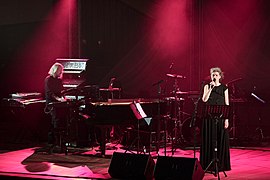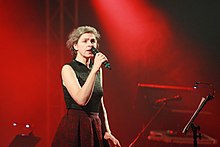Helium vola
| Helium vola | |
|---|---|
 Helium Vola performance in the Berlin Philharmonie as part of the XXX - The 30 Years tour by Deine Lakaien |
|
| General information | |
| Genre (s) | Medieval electronics , avant-garde |
| founding | 2001 |
| Website | www.helium-vola.de |
| Current occupation | |
Instruments |
Ernst Horn |
| Sabine Lutzenberger | |
Helium Vola is a German medieval electronics band, and was founded in 2001 by Ernst Horn , who was previously a founding member of Qntal and Deine Lakaien . In the contract with the record company, Horn insisted that Helium Vola should neither be seen as a Qntal successor nor marketed as such. The name of the band means "helium, fly!" - alluding to the noble gas helium , which is also used to make balloons fly.
Besides Ernst Horn, Helium Vola consists of the classically trained singer Sabine Lutzenberger. Several singers and instrumentalists, mostly with a classical background, are used for ensemble pieces and for the recordings.
Helium Vola interprets medieval poetry in a modern, electronic sound environment. This results in very danceable songs such as the single In lichter Farbe stands der Wald as well as pieces that are heavily based on samples (such as Funerali and Iuvenes on Helium Vola ).
The band is mainly a studio project. Nevertheless, there have been a few concerts over the years, at which Sabine Lutzenberger usually appears as the main interpreter.
founding
Helium Vola was founded in 2001 by Ernst Horn after he left the previous Qntal project. He felt a void afterward because he lacked the atmosphere of medieval poetry and music. With the new project, Ernst Horn wanted to find new ways to combine medieval poetry and music with a contemporary musical approach and current topics. The focus should be on electronics with self-created sounds. Horn also wanted to concentrate more on composition in order to develop more complex, structured and polyphonic pieces. It was important to him to use the simple but elegant and agile style of singing as it is found today in interpretations of medieval and early music . Horn began looking for a singer, a "lead voice", for his new project who had specialized in this direction. He bought many CDs from "early music" performers from all over Europe and was most impressed by a singer who lives and works in Augsburg - so close to his hometown Munich .
Sabine Lutzenberger worked with the "Ensemble for Early Music Augsburg", the Ensemble Mala Punica, and the Huelgas Ensemble and was already a renowned singer in this field. She agreed to take part in the project because it seemed a good opportunity to reach a different audience than usual. The name of the band refers to the noble gas, which is lighter than air and should reflect the playful idealism that Horn felt in connection with the project. Since "Helium" was already being used as a name by another band, he added the Italian "Vola", which means "to fly".
More voices were quickly found for the ensemble pieces - Gerlinde Sämann (soprano), Susan Weiland (soprano), Andreas Hirtreiter (tenor), Tobias Schlierf (bass) - and instrumentalists to produce the first single "Omnis mundi creatura". All the musicians in the project were and are at home in the “classical” music scene. The track was an instant hit in clubs and the debut album "Helium Vola" was released in 2001.
style
Like all following albums, the debut is a concept album . Horn combines the sinking of the Russian nuclear submarine Kursk in 2000 (the album is dedicated to the victims) and the reactions to this tragedy with songs about the youth, their love and how it is treated by older generations. The song structures here still follow a “classic” pop scheme, which takes a back seat in the following albums in favor of medieval styles such as madrigal or hymn . Nevertheless, the direction in which the project was developing can already be recognized in the debut, which often features cautiously introduced samples and electronic experiments. They serve the deep thoughts and emotions that Horn describes from various perspectives, communicated with great variability and precision by Lutzenberger. The project is not intended to simply convey medieval music and memories. Rather, Horn wants to show the general qualities of human life by combining the thoughts and ideas of the poets of the Middle Ages with those of modern people.
The second album "Liod" followed in 2004 and has a more stringent concept compared to the debut. It tells the story of a woman who is pregnant with an illegitimate child, treats her fate and that of the child who appears to die at the beginning but survives by a spell in the end. Instrumental, electronic experimental samples form a central theme for the album and replace the pure speech samples from the first album. The album contains clear quotations from "Omnis mundi creatura", which form a kind of leitmotif, as does the theme of the piece "La fille aux cheveux noirs", a poem by Houellebecq , whose poetry is already making its debut.
The last two albums so far "For you, who you love" and "Wohin?" are double albums in which ensemble pieces take up more space than before. In terms of composition, these reach their climax with the last piece on "Wohin?" in the style of the ars subtilior . The samples and electronic experiments merge with the vocal pieces. A very good example of this is the "widow's complaint" on "Where to?".
Texts
Helium Vola's texts are based on medieval poetry in a wide variety of ancient languages including mainly Old and Middle High German , Latin , Galician , Provencal and Italian . Horn associates several languages with specific music: Provencal with love songs, while Latin sounds strict and angular and he combines Old High German with its archaic character with electronic experiments. His idea is not to follow the medieval tradition exactly, but to emphasize the general and timeless topics such as love, death and nature but also political questions. If the concept of the album demands it, Horn also adds texts he wrote himself or the texts of other authors in modern Italian, English and German. The piece “DirIch” on “Wohin?” comes from the pen of Sabine Lutzenberger.
Concerts
Live performances by Helium Vola are rarely but enthusiastically acclaimed by fans. The entire ensemble played at the Wave-Gotik-Treffen 2002. Joel Frederiksen , a famous and highly acclaimed bass specialist in Renaissance music and Baroque music, who has accompanied the project since then, joined the group. Ernst Horn and Sabine Lutzenberger appeared twice as Helium Vola at the Digital-Analog-Festival Münichen (2002, 2007). Together they played some Helium Vola pieces as part of the XXX - The 30 Years Retrospective Tour by Deine Lakaien . Hannah Wagner, who played the Helium Vola Ensemble on their last album "Wohin?" normally plays some Helium Vola pieces at concerts of her own project, Saeldes Sanc . She is often accompanied by Ernst Horn.
Others
The first album, released in 2001, was one of the first CDs with copy protection (namely DOC.loc). It was therefore not playable on PCs and on some audio devices (e.g. car radios that were based on the cheap CD-ROM drives). Later editions no longer contained copy protection; In some cases, CDs with copy protection were exchanged.
Discography
Albums
- 2001: Helium Vola
- 2004: Liod
- 2009: For You Who You Love (double album)
- 2013: Where to? (Double album)
Singles
- 2001: Omnis Mundi Creatura
- 2004: Veni Veni
- 2004: The forest is in light color
Web links
- Official website
- Helium Vola at laut.de
- Helium Vola at Discogs (English)
- Helium Vola on MusicBrainz (English)
Individual evidence
- ↑ a b Colour-Ize (May 22, 2001) “Exclusive interview with Ernst Horn about Helium Vola” (accessed December 30, 2018).
- ↑ a b c d Sascha Blach (March 2013) “Helium Vola - Electric Railway into the Middle Ages”, Zillo, p. 16-17.
- ↑ Interview with Thomas Sabottka (March 27, 2004) “Helium Vola: The muse sounds in light color” Obliveon Metal and Gothic Magazin (accessed December 30, 2018).
- ↑ WK (2001) Features “Ideas, ideas, thirst for adventure” and “Our mortal bodies never become light” Notes 11/12 2001 (accessed December 30, 2018).
- ↑ Dagmar Munck (September 2, 2018) “Sabine Lutzenberger - a voice of early music” , SWR2 Zur Person, radio broadcast (accessed December 30, 2018).
- ↑ a b c Interview with Maik Heinsohn (September 25, 2001), Journal Nordsee-Zeitung (accessed December 30, 2018).
- ↑ Chrom Records “Helium Vola: Omnis Mundi Creatura” (accessed December 30, 2018).
- ↑ Interview with Michael Kuhlen (February 4, 2002), “Helium Vola - Busy Minnesinger” , Obliveon Metal and Gothic Magazin (accessed December 30, 2018).
- ↑ a b c d Interview with Michael Schäfer (May 2004), “Helium Vola - Liod” , Orkus Magazin 5/2004 (accessed December 30, 2018).
- ↑ Color-Ize Blog (February 22, 2013) "Helium Vola 'Where to?' - A Direction Search " (accessed December 30, 2018).
- ↑ Color-Ize Blog (October 15, 2012), letter from Ernst Horn to Color-Ize on colour-ize.de (accessed September 10, 2019)
- ↑ a b Manuela Ausserhofer (March 2013) “Lovelies, prayers and war cries!”, Orkus Magazin 3/2013, p. 103.
- ↑ Peter Heymann (March 2013) “Wanted - Found”, Sonic Seducer 03/2013, p. 60-61.
- ^ Wave-Gotik-Treffen (2002), band line-up (accessed December 30, 2018).
- ↑ Digitalanalog II (2002), program (accessed December 30, 2018).
- ↑ Digitalanalog 6 (2007), program (accessed December 30, 2018).
- ↑ Color-Ize Blog (October 4, 2016) (accessed December 30, 2018).
- ↑ "Analysis and evaluation of copy protection procedures for audio CDs" (PDF; 213 kB)

